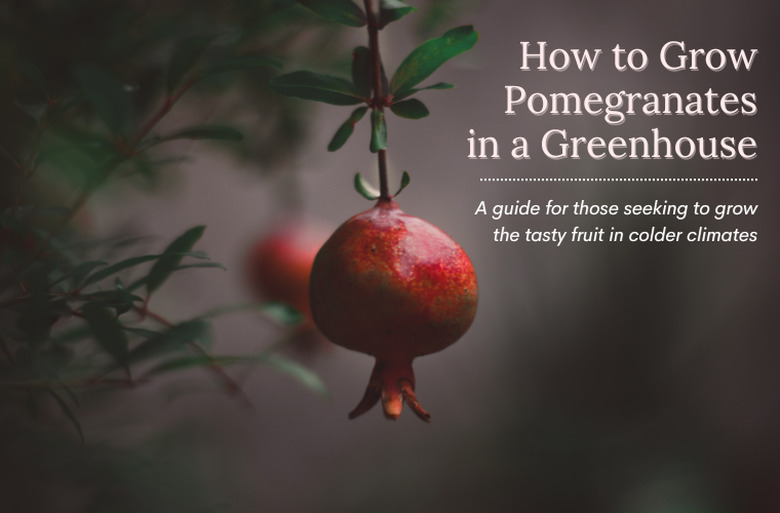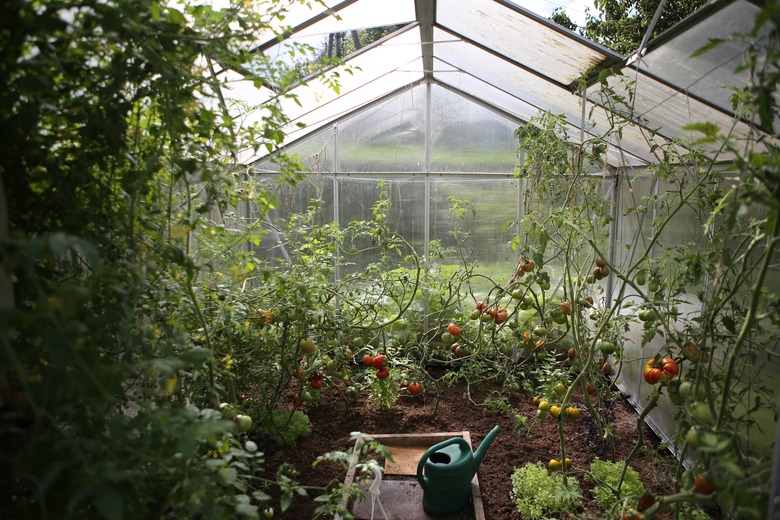How To Grow Pomegranates In A Greenhouse
Pomegranates grown in a pot inside a greenhouse may not bear a bumper crop, but they can still produce a few fruit if provided with the right growing conditions.
According to the North Carolina State University Cooperative Extension, pomegranate trees (Punica granatum) grow best outdoors in USDA plant hardiness zones 8b to 10a, although they also adapt well to greenhouse cultivation.
Growing pomegranates in a greenhouse is challenging, but it is the only option for gardeners in colder climates, and if done properly, any effort will be rewarded with a crop of juicy-seeded fruit in autumn.
Planting Pomegranates in a Greenhouse
With the specific challenges presented by greenhouse cultivation, it's important to start your pomegranates off right by choosing a proper pot size and providing optimal soil conditions.
Selecting the Right Pot Size
Choosing the right-size pot is a vital part of learning how to grow pomegranates in pots. According to Wilson Bros Gardens, a pomegranate that is 12 to 18 inches tall needs a 1-gallon pot. An 18- to 24-inch-tall plant needs a 2-gallon pot, and a 24- to 36-inch plant needs a 3-gallon container. A 5-gallon pomegranate tree bought from a nursery should be transplanted into a 10- to 20-gallon pot, and it will not need to be repotted again.
The pot can be made of any material, but a lightweight composite or plastic pot will be lighter and easier to move once filled with soil. Whatever pot you choose, make sure it has several drainage holes at the base so that water can drain away.
Tip
Choosing a lightweight composite or plastic pot will make it easier to move once filled with soil.
Setting Up Ideal Soil Conditions
Pomegranates tolerate a range of soil types as long as the soil is moderately fertile and fast-draining.
The University of Florida IFAS Extension recommends growing fruit trees in commercial potting soil or in a mix of one part sand, one part bark or perlite and one part peat, although coir is a more sustainable option than peat.
Do not use garden soil or reuse old potting soil for growing pomegranates in pots, because the soil can sometimes harbor harmful bacteria or insect eggs.
Growing a Greenhouse Pomegranate
Heat, light and humidity are all important factors when growing a pomegranate in a greenhouse.
Monitoring Temperatures and Sun Exposure
Pomegranates need full-sun exposure with some light midday shade in warmer climates, particularly in a greenhouse environment where temperatures can soar.
These light-loving Mediterranean trees perform best when temperatures stay above 85°F for 120 days each year, according to the University of Georgia Extension.
Nighttime temperatures must stay above 40°F for fruit to form, so adjust the greenhouse vents as needed and close them entirely if temperatures are predicted to fall below freezing.
Keeping the Humidity Levels Up
Pomegranates perform best when humidity is kept above 50 percent, although they will tolerate lower levels without suffering serious damage.
Pomegranates are self-pollinating and will produce fruit even when grown alone, but very high humidity can contribute to poor pollination. It is best to open the greenhouse vents for a few hours each day to release excess moisture.
Things Needed
- Container
- Commercial potting soil or sand, bark or perlite and peat or coir
- Greenhouse temperature and humidity gauge
- Liquid 7-9-5 or 15-15-15 fertilizer
Caring for Pomegranates Grown in a Greenhouse
Pomegranates need very little care even when grown in a greenhouse environment.
Maintaining the Moisture at Optimum Levels
Check the moisture level in the soil every few days or every day during very hot weather. Provide water whenever the soil feels completely dry on the surface, and then drench the soil until water drains from the bottom of the pot.
Although pomegranate trees are drought-tolerant, too little water will decrease fruiting, so it is important to never let the soil get too dried out. Likewise, too much soil moisture can cause root problems, so it is important to let the soil dry out in the top few inches between waterings.
Applying Fertilizer in the Spring
Pomegranates are normally not heavy feeders, but those grown in pots in a greenhouse benefit from light fertilizer applications from spring until harvest.
Logee's Plants for Home and Garden recommends feeding potted pomegranates with liquid 7-9-5 or 15-15-15 fertilizer at a rate of 1/2 teaspoon per gallon of water. Apply the fertilizer solution every two weeks and water well after feeding to distribute the fertilizer into the soil.
References
- North Carolina State University Cooperative Extension: Punica granatum
- Wilson Bros Gardens: How Old Or What Age Are Pomegranate Trees In 1, 2 And 3 Gallon Nursery Pots And Containers?
- Logee's Plants for Home and Garden: Cultural Information – Punica
- University of Georgia Extension: Pomegranate Production
- University of Florida IFAS Extension: Growing Fruit Crops in Containers

